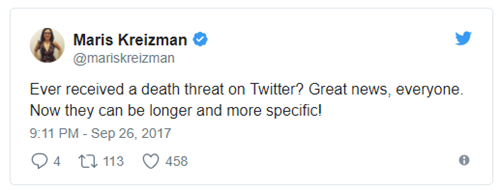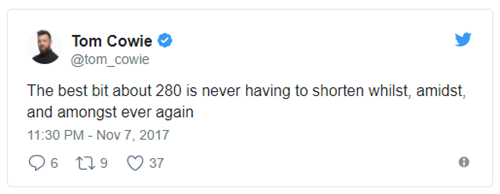Twitter has rolled out a new maximum tweet length of 280 characters, creating an astonishing divide in user opinion between 140-character purists and those welcoming the extra space. There are strong cases on both sides of the argument, so how do we weigh up the value of Twitter’s latest update?
Users wanted other changes to Twitter instead…
The backlash to Twitter’s rollout of the 280-character limit has taken many forms. While some have objected to what they perceive as a fundamental change to the platform, others are asking, “Why
this change?”
Over the years,
Twitter has expanded the number of usable characters in tweets, introducing link shortening and stopping quoted tweets taking up characters. The user response to these changes was neutral, so there is a degree of bafflement among users as to why the Twitter team has opted to make this change instead of granting other popular requests, such as introducing an Edit button or devoting greater efforts to dealing with spam and harassment.
Other users have pointed out that more characters mean more room for people to misuse their platform. Twitter’s unfortunate reputation as
a vehicle for trolls and hate speech is unlikely to be assuaged by its offering users more room to express their opinions, pleasant or otherwise.

…but 280 characters aims to make Twitter a friendlier place.
Twitter’s growth has slowed considerably in the past two years, with
recent figures showing slow rates of revenue growth and monthly active users. Paradoxically, though, its users remain highly engaged, with over
70% of users reporting they use it more than once a day. So, the issue isn’t with Twitter itself; the hard part is bringing new users on board.
The company believes that the key to growing its user base is making the service easier for newcomers to use. As Twitter CEO Jack Dorsey wrote last month in a letter to stakeholders: “We remain focused on making Twitter easier to use… based on research that indicates that running into the character limit can sometimes lead people to abandon their Tweets.”
Reducing obstacles - like the inability to finish a thought - could help achieve this, with the expanded character limit a crucial benefit. With
nine percent of tweets (in English) exceeding the old character limit, the extra space could be exactly what Twitter needs to bring new users on board.

Brevity is clarity – and isn’t that the point of Twitter?
Social media is an informal platform. It’s easy to slip into writing updates in the same style as we talk, writing down our thoughts as we think them and giving them the bare minimum of a sense-check before hitting ‘post’.
In 140 characters, this isn’t possible. With no characters to spare, we weigh up the importance of what we’re about to say a lot more carefully, reducing our updates to contain just the essentials. Can we trim out words or rephrase sentences for brevity? If we can, did we really need them in the first place?
The benefits of brevity are championed in copywriting:
Copyblogger recommends that a piece of writing should be ‘as long as necessary, and no longer’. A 140-character limit made us whip our writing into shape, shedding redundant weight in favour of clarity and concision. Now we’ve got brevity down to a fine art, what are we going to do with all those extra characters?

…but English speakers struggle to fit a thought into 140 characters.
You’ve trimmed your unnecessary adverbs and reworded your passive sentences, but your character count is still too high and cutting anything else will ruin the sense of your tweet.
But what if it isn’t your choice of words that’s inefficient? What if it’s the language you speak that’s the problem?
One of the driving factors behind Twitter’s decision to double the character limit was the varying efficiency with which different languages communicate information. As Aliza Rosen wrote in
Twitter’s blog announcing the rollout of the 280-character limit:
When I Tweet in English, I quickly run into the 140-character limit. Sometimes, I have to remove a word that conveys an important meaning or emotion, or I don’t send my Tweet at all. But when Iku Tweets in Japanese, he finishes sharing his thought and still has room to spare. This is because in languages like Japanese, Korean, and Chinese you can convey about double the amount of information in one character as you can in many other languages.
With more characters available, English-speaking Twitter users have the space to articulate a point fully, without having to truncate a thought beyond the point of fluency. This may also have positive effects from the perspective of brand voice: for example, if you’re tweeting on behalf of a business, you might well be relieved that you no longer need to replace ‘you’ with ‘u’ to conserve space.

The 280-character tweet has its benefits…
Whatever the general sentiment around the character change, the proof is in the pudding: users who trialled the new limit reported several positive changes to their Twitter activity because of it.
In their summary blog, Twitter’s researchers concluded that:
In addition to more Tweeting, people who had more room to Tweet received more engagement (Likes, Retweets, @mentions), got more followers, and spent more time on Twitter. People in the experiment told us that a higher character limit made them feel more satisfied with how they expressed themselves on Twitter, their ability to find good content, and Twitter overall.
It’s still early days for the new character count, so many businesses and individuals will have yet to see the effects of 280 characters on their own Twitter use. We’re fascinated to see how this develops, and we’ll continue to follow the new character rollout with interest.

… and old habits die hard, anyway.
Are you worried your writing skills will wither without the discipline of a tight character count? Concerned your feed will be full of inane dross and unchecked spambots now your followers have double the space to express themselves?
Fret not: you don’t have to use all your characters, and, in fact, much of the time you won’t. At the end of the 280-character trial period, Twitter staff observed that, after the novelty of having access to extra characters wore off, people’s tweets still tended to come in below 140 characters most of the time. In fact, they found that only 5 percent of tweets were sent out with more than 140 characters and, of those, only 2 percent were over 190 characters.
Twitter may now be eleven years old, but it’s still
the platform for microblogging. Its identity is rooted in its focus on brevity and efficiency in communication, and it’ll take more than an increased character count to change that.
